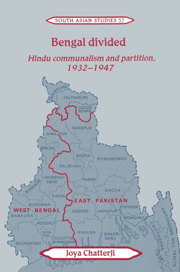Book contents
- Frontmatter
- Contents
- List of maps
- List of tables
- Acknowledgements
- List of abbreviations
- Glossary
- Map 1 Bengal districts
- Introduction
- 1 Bengal politics and the Communal Award
- 2 The emergence of the mofussil in Bengal politics
- 3 The reorientation of the Bengal Congress, 1937–45
- 4 The construction of bhadralok communal identity: culture and communalism in Bengal
- 5 Hindu unity and Muslim tyranny: aspects of Hindu bhadralok politics, 1936–47
- 6 The second partition of Bengal, 1945–47
- Conclusion
- Appendix
- Bibliography
- Index
- Cambridge South Asian Studies
2 - The emergence of the mofussil in Bengal politics
Published online by Cambridge University Press: 04 August 2010
- Frontmatter
- Contents
- List of maps
- List of tables
- Acknowledgements
- List of abbreviations
- Glossary
- Map 1 Bengal districts
- Introduction
- 1 Bengal politics and the Communal Award
- 2 The emergence of the mofussil in Bengal politics
- 3 The reorientation of the Bengal Congress, 1937–45
- 4 The construction of bhadralok communal identity: culture and communalism in Bengal
- 5 Hindu unity and Muslim tyranny: aspects of Hindu bhadralok politics, 1936–47
- 6 The second partition of Bengal, 1945–47
- Conclusion
- Appendix
- Bibliography
- Index
- Cambridge South Asian Studies
Summary
It has been remarked that ‘no other Indian city dominated its hinterland as completely as Calcutta dominated Bengal’. In the 1930s, however, the countryside emerged as a major arena of political activity, and, as urban preoccupations began to give way to rural issues as the focus of debate and conflict, Calcutta lost some of its former pre-eminence. The rise of the mofussil in Bengal politics was associated with two major developments of the thirties. The first was the Depression and the crisis of agrarian production relations that followed it; the second was the impact and growing influence of a rural electorate newly enfranchised by the reforms of 1935. While the Depression and the agrarian crisis fuelled unrest and conflict in the mofussil, the 1935 Act served to bring this conflict into the provincial legislature. The politicisation of the countryside was associated with the growing polarisation of politics around ‘communal’ lines and was to play a central role in shaping the course of Bengali politics in the following two decades.
Despite the big city of Calcutta, Bengal was a predominantly rural society. Criss-crossed by the rivers of the Gangetic delta, it had once been a highly fertile region, exporting rice to other parts of India. Gradually, however, the decay of Bengal's river systems, exacerbated by the construction of embankments and roadways and by the rise of parts of the delta above the level of inundation, reduced the fertility of the soil, particularly in western and northern Bengal.
- Type
- Chapter
- Information
- Bengal DividedHindu Communalism and Partition, 1932–1947, pp. 55 - 102Publisher: Cambridge University PressPrint publication year: 1994



